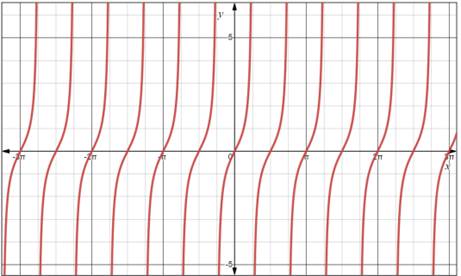
To identify: The graph of the function in terms of a basic trigonometric function. Locate the vertical asymptotes and graph two periods of the function
The vertical asymptotes of the graph
Given information:
The function
Explanation:
Consider the function
Graph the function

Compare the function
Then,
As
The shrink factor causes the vertical asymptote of
Thus, the vertical asymptotes of the graph
Chapter 4 Solutions
PRECALCULUS:GRAPHICAL,...-NASTA ED.
- Please find the open intervals where the functions are concave upward or concave downward. Find any inflection points also thanks!Note: This is a practice problem!arrow_forwardUse the graph below to evaluate each limit. -11 -10 -9 -8 -6 -5 -- + -0.3 -3 -2 -0.2 -0.1- ▼ 0 1 2 -0.1- -0.2- -0.3- 3. 4 5 -0 6 -0:4 -edit-graph-on- desmos lim f(x)= _9-←x lim f(x)⇒ x→1 ☐☐ lim f(x)⇒ +9-←x lim f(x)⇒ x→−4+ lim f(x)⇒ x→1+ lim f(x)= x→2+ lim f(x)⇒ x→-4 lim f(x)⇒ x→2arrow_forwardPlease show your answer to 4 decimal places. Find the direction in which the maximum rate of change occurs for the function f(x, y) = 3x sin(xy) at the point (5,4). Give your answer as a unit vector.arrow_forward
- let θ = 17π over 12 Part A: Determine tan θ using the sum formula. Show all necessary work in the calculation.Part B: Determine cos θ using the difference formula. Show all necessary work in the calculation.arrow_forwardCalculus lll May I please have an explanation about how to calculate the derivative of the surface (the dS) on the surface integral, and then explain the essentials of the surface integral?arrow_forwardУ1 = e is a solution to the differential equation xy" — (x+1)y' + y = 0. Use reduction of order to find the solution y(x) corresponding to the initial data y(1) = 1, y′ (1) = 0. Then sin(y(2.89)) is -0.381 0.270 -0.401 0.456 0.952 0.981 -0.152 0.942arrow_forward
- solve pleasearrow_forwardThe parametric equations of the function are given asx=asin²0, y = acos). Calculate [Let: a=anumerical coefficient] dy d²y and dx dx2arrow_forwardA tank contains 200 gal of fresh water. A solution containing 4 lb/gal of soluble lawn fertilizer runs into the tank at the rate of 1 gal/min, and the mixture is pumped out of the tank at the rate of 5 gal/min. Find the maximum amount of fertilizer in the tank and the time required to reach the maximum. Find the time required to reach the maximum amount of fertilizer in the tank. t= min (Type an integer or decimal rounded to the nearest tenth as needed.)arrow_forward
- Thumbi Irrigation Scheme in Mzimba district is under threat of flooding. In order to mitigate against the problem, authorities have decided to construct a flood protection bund (Dyke). Figure 1 is a cross section of a 300m long proposed dyke; together with its foundation (key). Survey data for the proposed site of the dyke are presented in Table 1. Table 2 provides swelling and shrinkage factors for the fill material that has been proposed. The dyke dimensions that are given are for a compacted fill. (1) Assume you are in the design office, use both the Simpson Rule and Trapezoidal Rule to compute the total volume of earthworks required. (Assume both the dyke and the key will use the same material). (2) If you are a Contractor, how many days will it take to finish hauling the computed earthworks using 3 tippers of 12m³ each? Make appropriate assumptions. DIKE CROSS SECTION OGL KEY (FOUNDATION) 2m 1m 2m 8m Figure 1: Cross section of Dyke and its foundation 1.5m from highest OGL 0.5m…arrow_forwardThe parametric equations of the function are given as x = 3cos 0 - sin³0 and y = 3sin 0 - cos³0. dy d2y Calculate and dx dx².arrow_forward(10 points) Let f(x, y, z) = ze²²+y². Let E = {(x, y, z) | x² + y² ≤ 4,2 ≤ z ≤ 3}. Calculate the integral f(x, y, z) dv. Earrow_forward
 Calculus: Early TranscendentalsCalculusISBN:9781285741550Author:James StewartPublisher:Cengage Learning
Calculus: Early TranscendentalsCalculusISBN:9781285741550Author:James StewartPublisher:Cengage Learning Thomas' Calculus (14th Edition)CalculusISBN:9780134438986Author:Joel R. Hass, Christopher E. Heil, Maurice D. WeirPublisher:PEARSON
Thomas' Calculus (14th Edition)CalculusISBN:9780134438986Author:Joel R. Hass, Christopher E. Heil, Maurice D. WeirPublisher:PEARSON Calculus: Early Transcendentals (3rd Edition)CalculusISBN:9780134763644Author:William L. Briggs, Lyle Cochran, Bernard Gillett, Eric SchulzPublisher:PEARSON
Calculus: Early Transcendentals (3rd Edition)CalculusISBN:9780134763644Author:William L. Briggs, Lyle Cochran, Bernard Gillett, Eric SchulzPublisher:PEARSON Calculus: Early TranscendentalsCalculusISBN:9781319050740Author:Jon Rogawski, Colin Adams, Robert FranzosaPublisher:W. H. Freeman
Calculus: Early TranscendentalsCalculusISBN:9781319050740Author:Jon Rogawski, Colin Adams, Robert FranzosaPublisher:W. H. Freeman
 Calculus: Early Transcendental FunctionsCalculusISBN:9781337552516Author:Ron Larson, Bruce H. EdwardsPublisher:Cengage Learning
Calculus: Early Transcendental FunctionsCalculusISBN:9781337552516Author:Ron Larson, Bruce H. EdwardsPublisher:Cengage Learning





